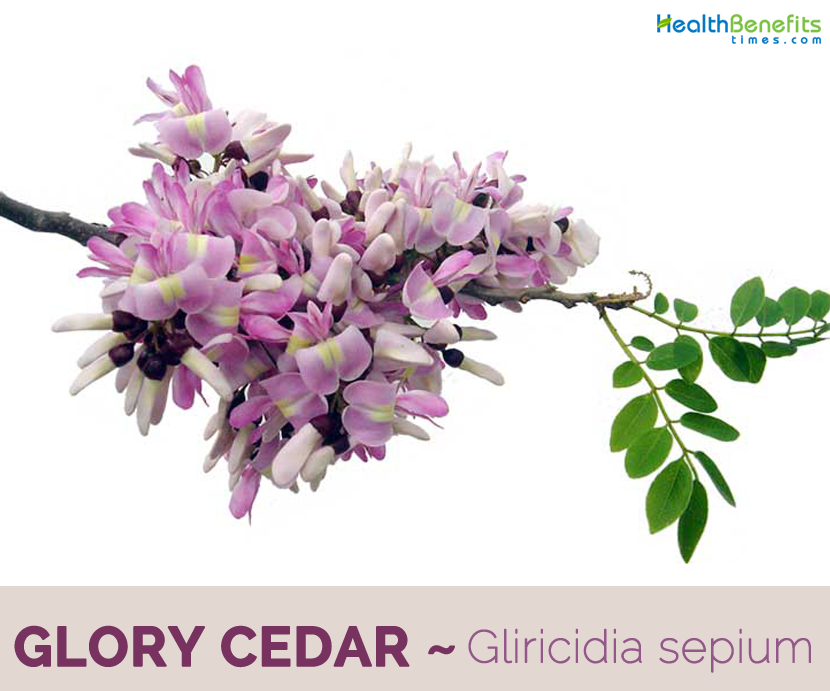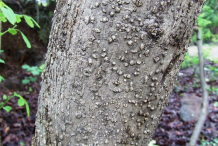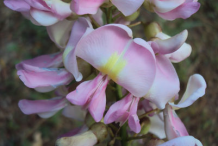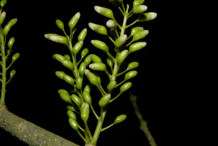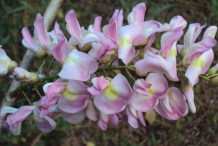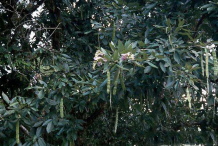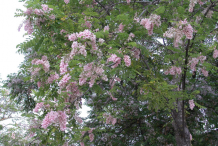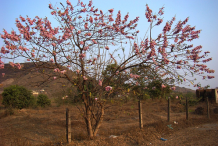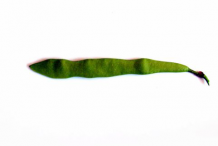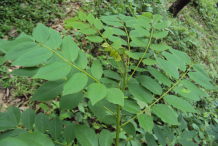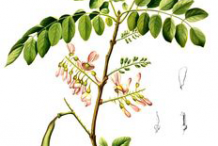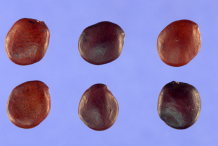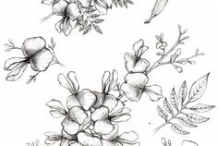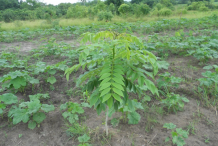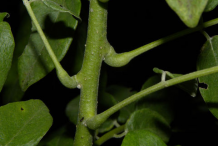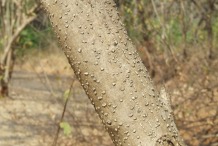It is considered as the second most important multi-purpose legume tree, surpassed only by Leucaena leucocephala. The tree is used in many tropical and sub-tropical countries for various purposes such as live fencing, fodder, coffee shade, firewood,[4] green manure and rat poison. Gliricidia can be intercropped with maize. Its effect is that of a potent fertilizer. G. sepium is also used for its medicinal and insect repellent properties. Farmers in Latin America often wash their livestock with a paste made of crushed G. sepium leaves to ward off torsalos. In the Philippines, the extract obtained from its leaves is used to remove external parasites.
Plant Description
Glory Cedar is a small to medium-sized, thorn less, deciduous, single- or multiple-stemmed tree that grows about 10–12 m tall with smooth, weakly fissured, whitish grey to deep red brown bark and a trunk diameter of 30 cm at breast height (dbh). The plant is found growing in dry to wet hillsides and thickets or in forests of the plains, often in pastures or along roadsides, frequent in second growth or in fields or pastures. The plant is adaptable to a wide range of soil types on sands, heavy clays and slightly alkaline, calcareous limestone soils but does best in well-drained soils. Gliricidia detests wet or waterlogged soils. The stem and branches are commonly flecked with small lenticels. Trees display spreading crowns.
Leaves
Leaves are alternate or sometimes sub-opposite, pinnate, 15-35 cm long, with slender, yellow-green, finely hairy rachis, an odd terminal leaflet, and 6-24 opposite (except in upper part of rachis) leaflets per leaf. Leaflets are narrowly elliptic to elliptic, rarely broadly elliptic, usually pointed at tips, 4.4-8.3 cm long, and 1.7-4.8 cm wide, larger towards tip of the leaf, with characteristic dark purplish tannin patches scattered, especially on lower surface.
Flower & fruit
The flowers are borne on erect, 2-15 cm long racemes arising from leaf axils, or on leafless nodes of older stems with almost synchronous maturation of 30-100 flowers on a single inflorescence. The flowers are typical of Papilionoid legumes, borne on short 5-11 mm long slender pedicels, 2 cm long, with a five-lobed campanulate (bell-shaped) calyx and a typical pea-shaped whitish-pink or purple corolla with five strongly unequal petals. The standard petal is light pink, or pink with a deep yellow basal blotch, and the blade is reflexed at 180° when the flower is fully open. The wing and keel petals are also usually pink. There are 10 whitish stamens, 9 united into a tube and one free. Flower is followed by pods that are 10-17 cm long and 1.4-2.2 cm wide, strongly compressed. Fruits appears in green or tinged reddish purple occasionally at unripe condition, while in ripen condition they appear in light yellow brown and looks like round in shape and opening explosively when dry with the pod valves twisting into tight spirals after dehiscence. There are 3-10 lenticular, rounds or elliptic, yellow-brown, darker orange-brown, seeds per pod, 8.5-11.5 mm in diameter.
According to World Agroforestry Centre, this species is becoming an important part of farming practices in Africa. G. sepium has a combination of desirable properties. Because it fixes nitrogen in the soil, it boosts crop yields significantly without the expense of chemical fertilizers. In addition, it tolerates being cut back to crop height year after year. The trees go into a dormant state when they are cut back, so the root system is not competing straight away for the nutrients, and the crop is free to become established. The trees only really start to come out of the dormant phase when the crop is already tall.
Origin and geographic distribution
Gliricidia is a native of the seasonally dry Pacific Coast of Central America. It has long been cultivated and is naturalized in tropical Mexico, Central America and northern South America. It was also introduced to the Caribbean and later to West Africa. The Spaniards took it to the Philippines in the early 1600s. From Trinidad it was taken to Sri Lanka in the 18th Century; from there it reached other Asian countries including Indonesia (about 1900), Malaysia, Thailand and India.
Traditional uses and benefits of Glory Cedar
- The plant is used as an antihistaminic, antipyretic, expectorant and diuretic; crushed fresh leaves are applied as a poultice in Mexico.
- Leaves are brewed as tea, sweeten and drank for cough and asthma in Saint Lucia.
- Leaves are also useful for skin infections.
- Peasant in San Jacinto in northern Columbia uses the flower liquid to clean eyes.
- Decoction of leaves is used for urticaria, rash and also in burns and erysipelas in Panama.
- Bark decoction is used against bacterial and protozoal infections in Guatemala and Costa Rica.
- sepium extracts have been used to treat infections produced by Microsporum canis, Trichophyton mentagrophytes and Neisseria Gonorrhea.
- Leaf juice or decoctions of the leaf, root and bark are used for scabies and dermatitis and as antipruritic on the skin in Philippines.
- Fresh leaves are applied to skin as insect repellent.
- Crushed leaves applied for rheumatic pains, sprains and closed fractures.
- Sap of bark, leaves and roots has also been used for wound healing.
- Bark and leaves are used to treat skin diseases in Guatemala
- In other countries, the plant is used for headache, bruises, burns, colds, cough, fever, fatigue, gangrene, gonorrhea, skin itches and sores and as antidote, insecticide and insect repellent.
- Plant is a folk remedy for alopecia, boils, bruises, burns, colds, cough, debility, eruptions, erysipelas, fever, fractures, gangrene, headache, itch, prickly heat, rheumatism, skin tumors, ulcers, urticaria and wounds.
- Juice of the leaves, bark and roots is used as a traditional anti-dermatophyte to control eczema and to alleviate itches and wounds.
Culinary Uses
- Gliricidia leaves and flowers are said to be eaten boiled or fried.
- Flowers are utilized as food in Mexico.
- Flowers are cooked in egg batter and fried or cooked as potherbs.
- Flowers attract honeybees and are a good source of nectar.
- They are also folded into a batter and fried.
- They are used in a fish dish.
Other Facts
- Gliricidia is often planted as a living fence.
- Foliage is harvested and used as green manure and cut-and -carry fodder for large and small ruminants.
- Branch is cut for fuel wood.
- Gliricidia leaf meal was found to be a useful additive in dietary supplements for laying hens.
- Leaves are placed on bananas in containers to hasten ripening.
- Gliricidia has been planted to reforest and better uncovered areas and reduce soil erosion, as windbreaks and firebreaks.
- It is widely cultivated as shade trees for cocoa, coffee and tea, and yams and also as live support trees for pepper and vanilla and as an understory crop in coconut plantations and in alley farming.
- It yields timber which is hard, heavy, durable, strong, coarse structured, easily worked and polished and is resistant to termites and rots.
- Wood is widely used for railway ties, posts, heavy construction, furniture, farm implements, tool handles and small articles.
- Wood is a useful source of fuel-wood.
- sepium wood ash could be formulated with cement for concrete ad mixture as construction material for low-cost housing.
- Various parts of the tree have been reported to have pesticidal properties.
- Toxic seeds, bark, leaves and roots are used as rodenticide to poison rodents.
- Branches are strewn in rice fields to help deter rice pest such as caseworm and whorl maggot in Philippines.
- Farmers in Latin America often bathe their livestock with a paste made of crushed G. sepium leaves to ward off tarsalos.
- Extract obtained from its leaves is used to remove external parasites such as fleas and ticks from cattle and dogs in Philippines.
- Tree is used in many tropical and sub-tropical countries for various purposes such as live fencing, fodder, coffee shade, firewood, green manure and rat poison.
Precautions
- Leaves, seeds or powdered bark are toxic to humans when mixed with cooked rice or maize and fermented.
- They are used to poison rats, mice and other rodents.
- All parts of plant are poisonous if ingested.
References:
https://www.itis.gov/servlet/SingleRpt/SingleRpt?search_topic=TSN&search_value=502803#null
https://davesgarden.com/guides/pf/go/71053/
http://www.hear.org/pier/species/gliricidia_sepium.htm
https://npgsweb.ars-grin.gov/gringlobal/taxonomydetail.aspx?id=17647
https://www.pfaf.org/USER/Plant.aspx?LatinName=Gliricidia+sepium
https://www.cabi.org/isc/datasheet/25380
http://www.theplantlist.org/tpl/record/ild-2406
https://plants.usda.gov/core/profile?symbol=GLSE2
https://en.wikipedia.org/wiki/Gliricidia_sepium
https://uses.plantnet-project.org/en/Gliricidia_sepium_(PROSEA)
https://www.hort.purdue.edu/newcrop/duke_energy/Gliricidia_sepium.html
Comments
| Glory Cedar Quick Facts | |
|---|---|
| Name: | Glory Cedar |
| Scientific Name: | Gliricidia sepium |
| Origin | Mexico and Central America, |
| Colors | Green or tinged reddish purple when young turning to light yellow brown as mature |
| Shapes | Pod oblanceolate, 10–18 cm long, 2 cm wide, valves twisting in dehiscence |
| Health benefits | Beneficial for headache, bruises, burns, colds, cough, fever, fatigue, gangrene, gonorrhea, skin itches , wound healing |


